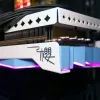Final words and conclusion
The Yeston Sakura Hitomi version of RX 7800XT is a good card. It's performing in the range you'd expect from a product with a bit higher GPU frequency (vs the reference settings). The cooling solution used here is enough for such a GPU. Same as in the previously reviewed Yeston RTX 4070 Ti, the undervolting provides a lower power consumption, fan noise, and temperature while maintaining a similar level of frequency/performance to stock. It would help if you remembered - that overclocking and undervolting can help improve your system's performance; damaging your hardware is always possible. Please proceed with caution and at your own risk.
As for the other things, you will find the standard (two) 8-pin new power connectors, which shouldn't raise concerns about melting the cable/connector. There's the AV1 compatibility, incorporation of the rDNA3 architecture, and updated monitor connectors, all of which enhance the overall user experience.
Performance
RX 7800XT provides enough performance for enthusiast gamers to play up to UWHD and QHD monitor resolutions (sometimes enabling the FSR will be a must). This card is designed for precisely that kind of gamer. The RTX 40 series now has a new generation of Ray tracing and Tensor cores that are more powerful. Overall, the Radeon RX 7800XT makes sense at resolutions up to 2K 2560x1440/3440x1440; performance with FSR2 is noteworthy, and enabling FSR is recommended.
Cooling & noise levels
Under heavy full load, the card tested uses about 250-265 Watts (average). This Wattage is directly related to how much heat the GPU, which sits inside a closed case, gives off. For acoustics, we reached 37 DB. You can expect the card to get 60-75°C when stressed. This value can increase depending on how well air moves through your chassis. FLIR imaging doesn't show anything alarming.
Energy consumption
The power draw under intensive gaming for Radeon RX 7800XT is moderate, especially when energy prices are soaring; this product isn't a good example. We measured it close to the 265-watt range (TBP).
Coil whine
Any Radeon RX 7800XT can exhibit coil squeal. It's just a matter of how much exactly. Graphics cards all make this in some sort or form, especially at high framerates. In a closed chassis, that noise would fade away in the background. However, you can listen to the coil whine/squeal with an open chassis. The Yeston had no noticeable sound, so that was a bit surprising.
Tweaking/undervolting
The card tweaks well. The clock frequency can take a good +200 MHz extra. Apply it, and you'll see the GPU boost clock hovering at the 2700-2750 MHz domain (frequencies vary per game title as they are dynamic). The memory could be tweaked to 20 Gbps, so all these are decent values that brought 7~8% additional performance on challenging GPU situations, measured from reference performance.
As for the undervoling. After setting the voltage to 1.00 V (from default 1.15 V) - it made the biggest impact. You do not lose the performance, but the power consumption dropped by 45 W (almost 25% of the default figure) when having a full load and 35 W on average for games (so it dropped by around 15% without sacrificing the results). You can't forget about another great factor after the so-called UV. What's that? The cooling system will be quieter, and you'll get lower temperatures! That's a no-brainer.
Conclusion
Yeston offers the Sakura Hitomi series as premium graphics cards. The Yeston RX 7800XT Sakura Hitomi has a unique appearance thanks to the three colors used for the cooler shroud and backplate. Three DisplayPort and one HDMI are available as video outputs. The aluminum backplate has a modern brushed finish and is supplied. There's a dual-BIOS switch. The Radeon RX 7800XT is doing well in hardware and performance. It uses the Navi 32 GPU, which has a chiplet design. AMD is using that already in the Ryzen CPUs, and you get several smaller "parts" (GCD, Graphics Complex Die - with all the shaders/MCD, Memory Cache Dies), instead of one bigger one - which should lower the failure rate when manufacturing it. On the 7800 XT, you can find four MCDs, which provide 256-bit memory support. By tweaking/undervolting the card, you can gain 7-8% performance and ensure suitable performance up to 2560x1440 resolutions. When you undervolt it, you can decrease the power consumption by around 20-25% during the load. That's a great result, especially because you do not lose the performance, even if you'd set the voltage to 1.00 V (the default one is 1.15 V). But that's not all; you also improve the temperatures and fan noise. As expected, the ray tracing performance of RX 7800 XT is lower than its NVIDIA counterparts. The 16GB card offers enough power for the time being with most titles and the combination of QHD. Yeston RX 7800XT card is a good-quality product, performing nicely (including the cooling solution, which provides a very good noise/temperature ratio). Still, the price is 599 USD, 100 USD more than the MSRP, which lowers our note to "Bronze.", as you can find less expensive (and not necessarily worse) versions from the other manufacturers.
You can give Yeston a visit here.- Download NVIDIA GeForce drivers.
- Sign up to receive a notification when we publish a new article.
- Or go back to Guru3D's front page.



